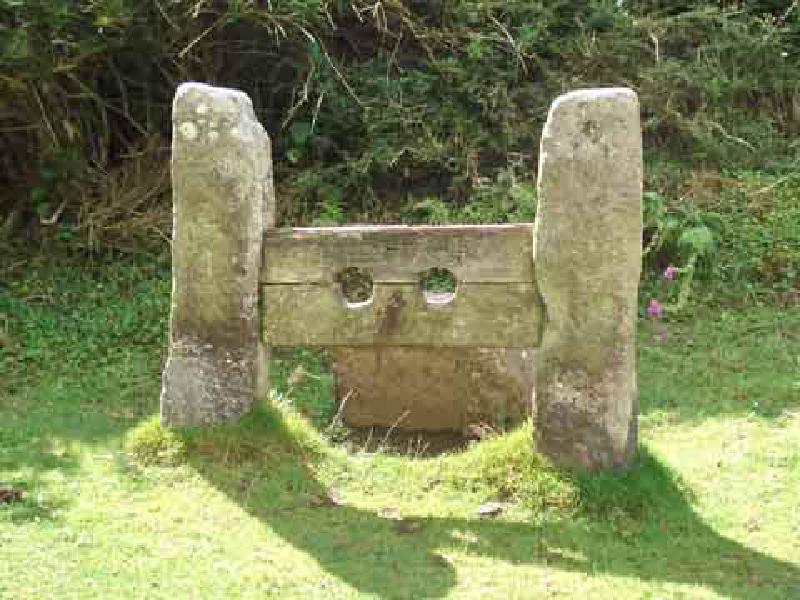Information
- Distance: 3 miles, walked by Keith Ryan and transcribed by Simon Avery
- Grade: Gentle
- A GPX route of this walk is available: Download GPX
- Directions to Car Park
- What Three Words
dentures.droplet.alerting
Map

Introduction
Belstone is one of the prettiest villages on Dartmoor and retains a strong farming link. The large lawn slopes away down to an ancient ford and often has Dartmoor Ponies and sheep grazing. This was once a mining village, with the valley between Belstone and Sticklepath hugely industrialised, although it’s hard to see traces of that now.
Belstone Stocks

Once present in most villages, stocks were used to shame and punish transgressors - often for crimes against the church. The victim was secured in place so that anyone passing could taunt them, or throw rotten fruit at them - I’m sure many old grudges were settled here.
The stocks themselves have been replaced many times, and it’s reported that a blow up doll was punished here for the village’s Millenium celebrations.
Legendary Dartmoor - Belstone Stocks
Memorial Stone


GRV
22.VI 1911
GRV = George Rex V
King George V - Coronation 22 June 1911

E II R
1952 2002
Commemorating 50 years reign of Queen Elizabeth II who acceded to the throne on the death of King George VI on 6 Feb 1952
The Pound

Zion Chapel and Telegraph Office

The sign above the door says “Telegraph Office” and there is a more modern telephone box outside, also an old Post Collection Box in the wall.

Before it was a Telegraph Office (1937-1979) this building was a Zion Methodist Chapel (1840-1841) and Sunday School. (1856-1899)
St Mary the Virgin Church

A church was first built here in 1260.

Incised Celtic Cross

This celtic cross has moved around. Believed carved between the 7th and 9th centuries AD, William Crossing writes that it was rediscovered at this chapel when some stairs were taken down in 1861. It was then taken to a nearby rectory and built into a wall. It was returned here in 1920 when the Old Rectory was abandoned

For our walk, we leave the village now by taking the road to the Northwest, before turning left into a path and then out onto the moor at Old Rectory Farm - the site where the above cross spent some time
Belstone Cleave Rocks




We turn back south now, but follow the contour path due Southwards around the enclosures
Watchett Hill Cottage

Watchet Hill Cottage, also known as Black Hut or Black House, was built around 1800 and last occupied in the mid 1960s before falling into disrepair.
Notably, the author Eden Philpotts stayed here before making the house of the main locations in his famous novel, The Secret Woman.
“The mean dwelling house of Watchet Hill faced north. Plain, tar-pitched, and slated, it huddled on the great slope - a blot against the gleaming furzes that rippled to its side. –Eden Phillpotts, The Secret Woman. 1905

Follow the path South until we’re clear of the walls on our left, then turn left and walk Eastwards until…
Nine Maidens

Here were once nine young ladies who dared to dance on the Sabbath and were so turned to stone. A single stone apart from the others was the piper who played a tune for them, and he was similarly treated.
Apparently, if you visit at noon or when the Belstone church bells ring, you can see the stones swaying gently.
This stone circle was originally a burial mound or kistvaen covered in earth. The grave was robbed many years ago, and the mound of earth to the Southwest was likely what was dug off.
As known as: The Dancing Stones. The Seventeen Brothers. The Nine Stones.
Benchmark

Benchmarks in stone walls are rare on Dartmoor - farmers know that stone is often moved when walls are rebuilt, although perhaps this example was thought too large to be easily relocated.

Benchmarks are fixed reference points used for surveying, often employed by the Ordnance Survey
Follow the paths to the Northeast as we start to descend back to the Village

The Tarka Trail is a long distance foot and cyclepath taking a figure-8 tour of places described by Henry Williamson in his 1927 novel Tarka the Otter.
Water Works


The Tors



Parking
There’s a good sized parking area on the approach to the village. It’s best to avoid driving through the village itself as it can be busy with pedestrians in the Summer.
